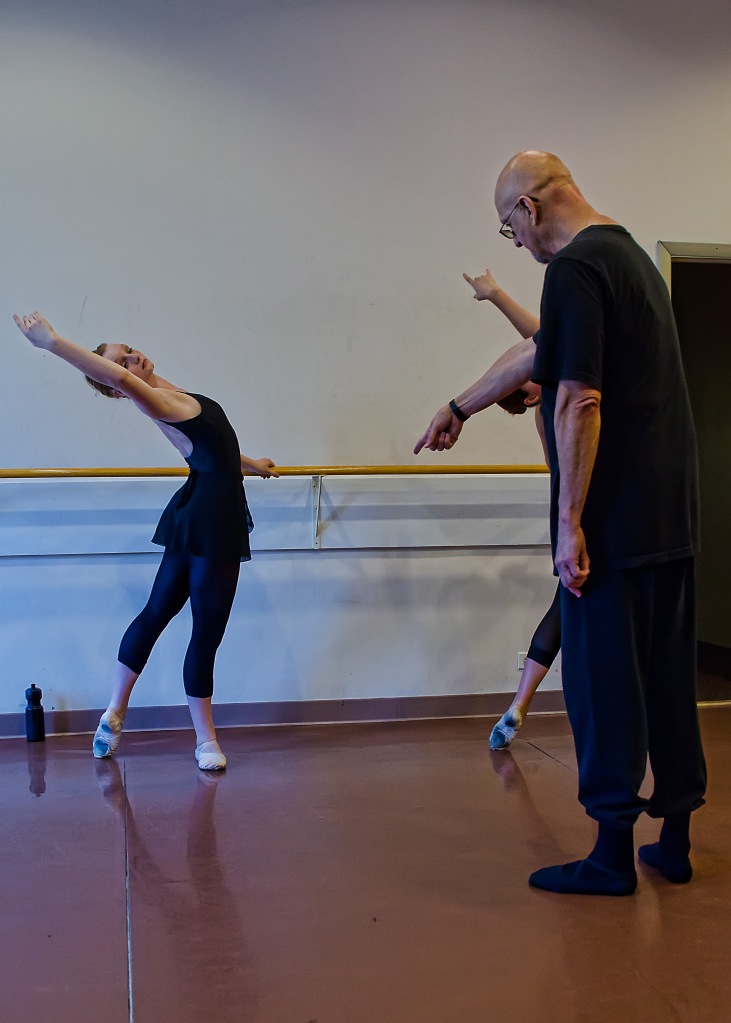July 20, 2012
Post by Christina Salerno, SCB Alumna and Executive Director
Photos of Guest Teacher, Randy Newsom, and SCB dancers by Scott Lewis
One of the most special and incredible aspects of dance is its capacity to highlight the human body’s ability to coordinate muscles, memory, and breath in concert with music. Dance is often compared to athletics, and rightly so on many fronts, but dance exhibits a highly refined level of coordination not often displayed by other athletic pursuits. Dance searches for an ideal, but that ideal is not an end unto its own. To use a basketball analogy, it is not IF you score a basket, it IS the shape of your legs, arms, fingers, WHILE scoring a basket that makes the difference. And the ball must pass the hoop at precisely the moment that the choreographer has envisioned the ball passes through the hoop. And there must be passion in the whole persona of the individual making the basket. Not just JOY, but ELATION, possibly with emotion that simultaneously portrays what came just before as well as what is yet to be revealed.

Legs and Arm coordination
To train one’s body to be perfectly coordinated is an ongoing process for any dancer ~ a life long quest for perfection. As an American Ballet Theatre Ballerina once remarked to me, “To become a dancer, you really need to love attention to detail, you need to be able to work for hours on tedious things such as where your little finger is in second position [of the arms].”

A brief stop in sequencing
Each choreographer adds a new dimension to coordination. Some challenge the limits of the mind to string together repetitive elements with slight variations (think the finale of “Four Temperaments” by Balanchine, the “Adolescents” dance in MacMillian’s “Rite of Spring”), some ask the body to work independently of its individual parts (think “Breakers” by Cunningham and countless works by Wayne MacGregor), some repeat signature choreography in multiple ways, on multiple characters/dancers (think Petipa’s “Sleeping Beauty” prologue, Balanchine’s “Symphony in C”), some challenge the dancer to coordinate without the luxury of music (think Morris’ “Gong”), some require incredible speed and precision (think Ashton’s “Scenes de Ballet” and “Med. Diverts” from “Ondine”), some require dancers to make the most out of the languid movement (think Duato’s “Songs without Words”), some ask dancers to luxuriate angularity and sensuality simultaneously (think Wheeldon’s “Tryst”)…….in advance of any comments, I would like to here add that truly great works exhibit multiple expressions of coordination. A case could be made for any of the above, as great works each in their own right, that each of them could and does exhibit aspects of coordination on multiple platforms.
Similarly, each teacher brings new elements of coordination to each individual student. Guest teachers benefit from the fact that what they bring to the ballet studio is somehow different, challenging and unique to what has been developed prior to that teacher’s arrival. No matter that the basic technique is the same, no matter that the corrections are similar to what is said repeatedly both before and after the guest instructor graces the studio. What the guest brings is a fresh perspective, a new look at how to coordinate one’s body and mind. And if that teacher also introduces some Bourneville, Graham, Leon, et al. along the way, then those dancers become annointed to have yet another chance to expand their individual level of coordination.

Coordinating a movement backwards
Posted in ballet, dance, education of a dancer |
Leave a Comment »



